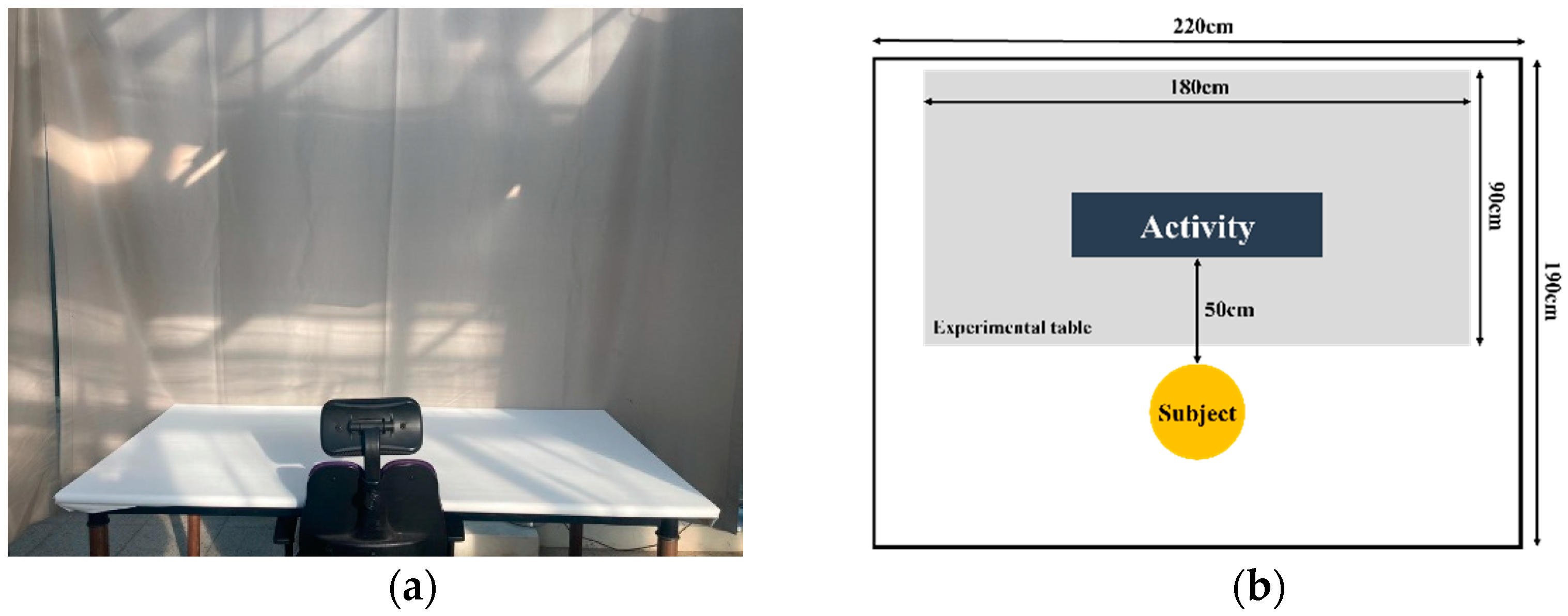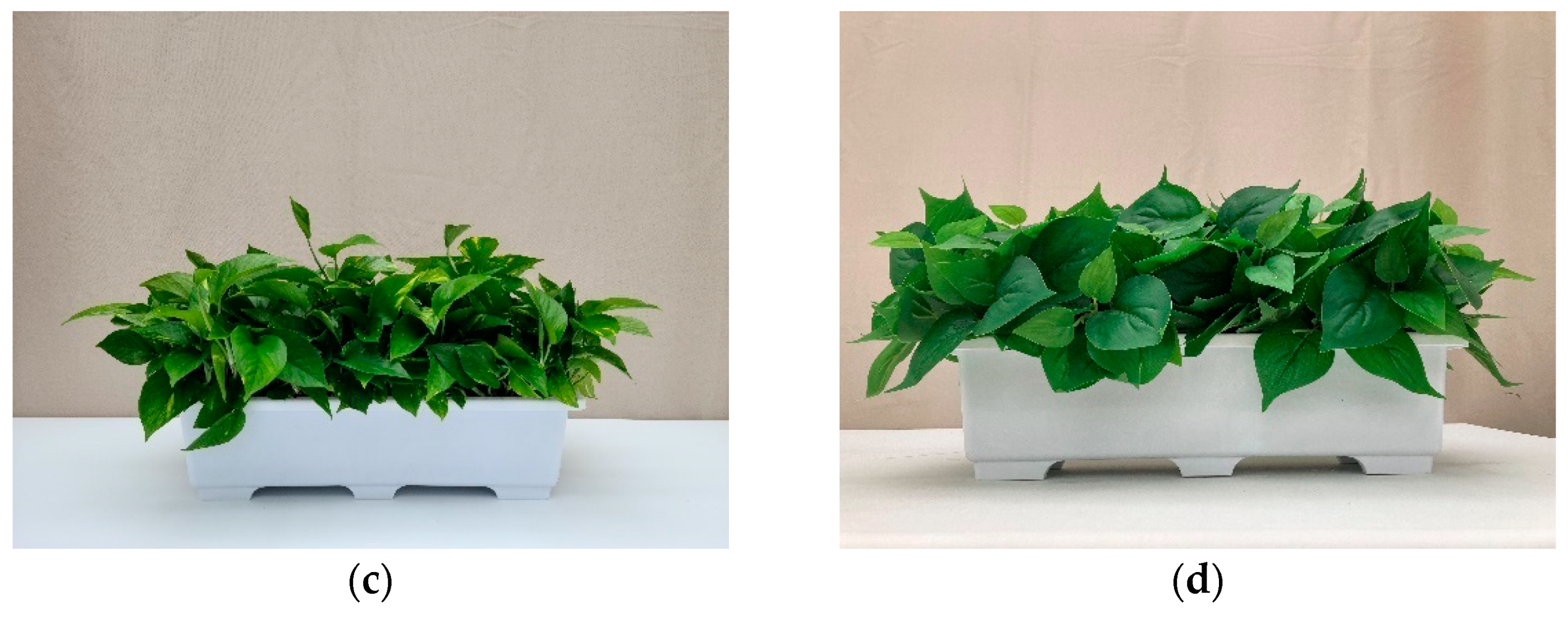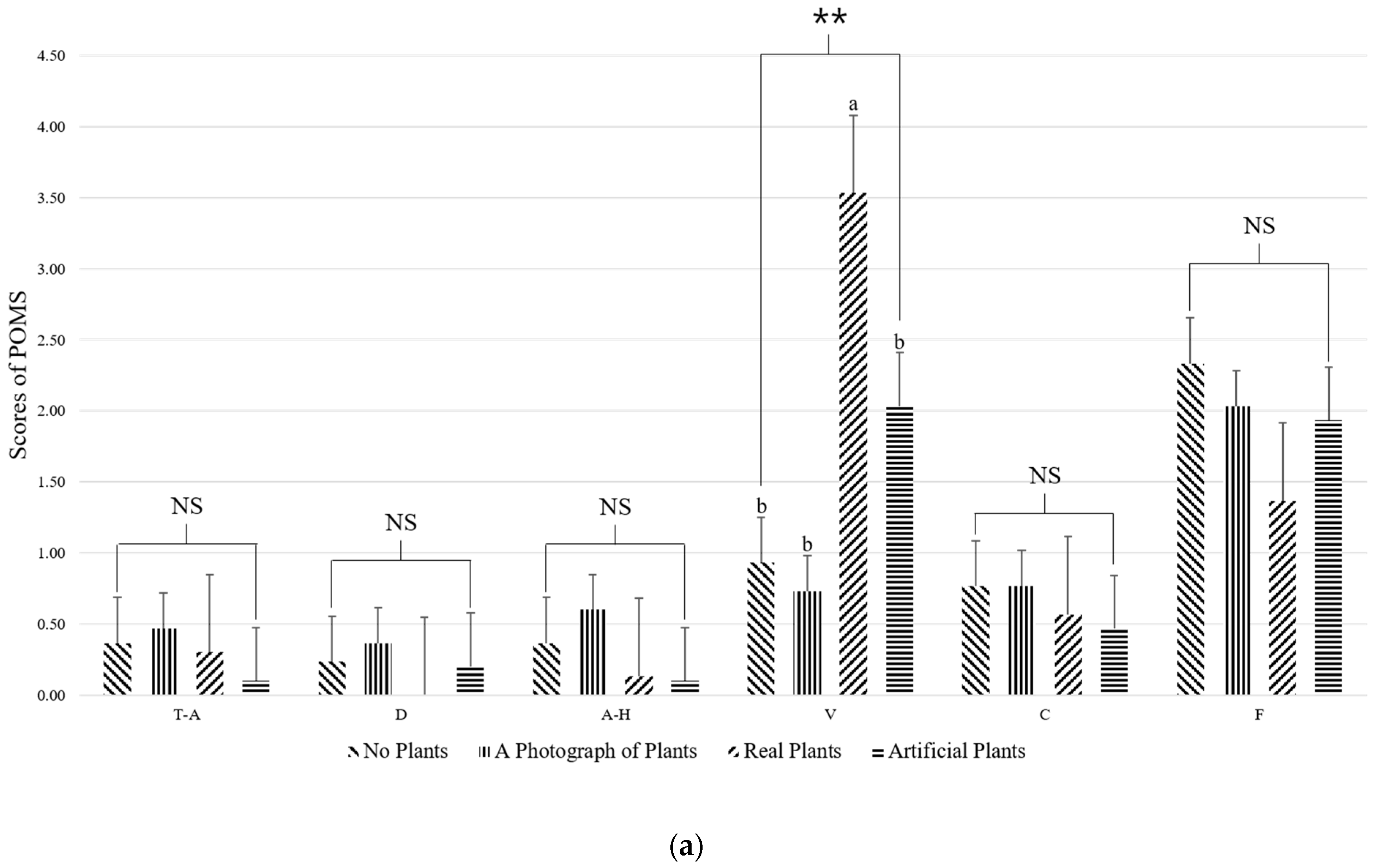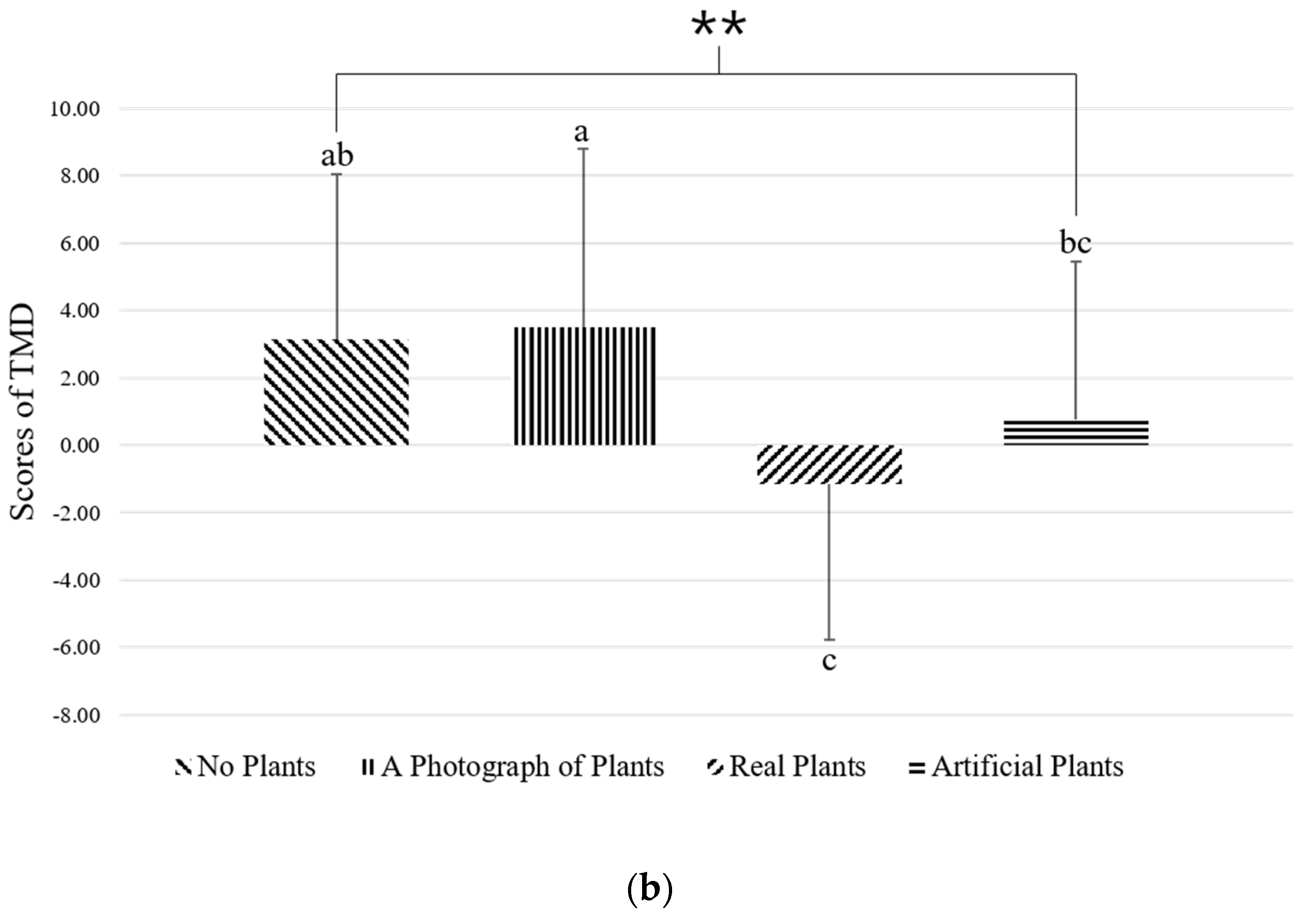Physiological and Psychological Effects of Visual Stimulation with Green Plant Types
Abstract
1. Introduction
1.1. The Effects of Natural Environment on Human Psychophysiology
1.2. A Prior Study on the Effects of Plants on Human
2. Materials and Methods
2.1. Participants
2.2. Experimental Environment
2.3. Experimental Materials and Treatment
2.4. Experimental Procedure
2.5. Measurement
2.6. Data Analysis
3. Results
3.1. Descriptive Characteristics
3.2. Electroencephalography (EEG)
3.3. Results of the Subjective Mood Evaluation According to the Type of Visual Stimulation Presented
4. Discussion
5. Conclusions
Author Contributions
Funding
Institutional Review Board Statement
Informed Consent Statement
Data Availability Statement
Acknowledgments
Conflicts of Interest
References
- Stilgoe, J.R. Gone barefoot lately? Am. J. Prev. Med. 2001, 20, 243–244. [Google Scholar] [CrossRef]
- Ulrich, R.S.; Simons, R.F.; Losito, B.D.; Fiorito, E.; Miles, M.A.; Zelson, M. Stress recovery during exposure to natural and urban environments. J. Environ. Psychol. 1991, 11, 201–230. [Google Scholar] [CrossRef]
- Chiesura, A. The role of urban parks for the sustainable city. Landsc. Urban Plan. 2004, 68, 129–138. [Google Scholar] [CrossRef]
- Tyrväinen, L.; Ojala, A.; Korpela, K.; Lanki, T.; Tsunetsugu, Y.; Kagawa, T. The influence of urban green environments on stress relief measures: A field experiment. J. Environ. Psychol. 2014, 38, 1–9. [Google Scholar] [CrossRef]
- Frumkin, H. Beyond toxicity: Human health and the natural environment. Am. J. Prev. Med. 2001, 20, 234–240. [Google Scholar] [CrossRef]
- Maas, J.; Verheij, R.A.; Groenewegen, P.P.; de Vries, S.; Spreeuwenberg, P. Green space, urbanity, and health: How strong is the relation? J. Epidemiol. Community Health 2006, 60, 587–592. [Google Scholar] [CrossRef] [PubMed]
- Cohen, S. Environmental load and the allocation of attention. Adv. Environ. Psych. 1978, 1, 1–29. [Google Scholar]
- Orians, G.H. An ecological and evolutionary approach to landscape aesthetics. Landsc. Mean. Values 1986, 3, 25. [Google Scholar]
- Kaplan, R.; Kaplan, S. The Experience of Nature: A Psychological Perspective; Cambridge University Press: Cambridge, UK, 1989. [Google Scholar]
- Lee, J.; Park, B.-J.; Tsunetsugu, Y.; Ohira, T.; Kagawa, T.; Miyazaki, Y. Effect of forest bathing on physiological and psychological responses in young Japanese male subjects. Public Health 2011, 125, 93–100. [Google Scholar] [CrossRef]
- Jiang, M.; Hassan, A.; Chen, Q.; Liu, Y. Effects of different landscape visual stimuli on psychophysiological responses in Chinese students. Indoor Built Environ. 2019, 29, 1006–1016. [Google Scholar] [CrossRef]
- Markevych, I.; Tiesler, C.M.; Fuertes, E.; Romanos, M.; Dadvand, P.; Nieuwenhuijsen, M.J.; Berdel, D.; Koletzko, S.; Heinrich, J. Access to urban green spaces and behavioural problems in children: Results from the GINIplus and LISAplus studies. Environ. Int. 2014, 71, 29–35. [Google Scholar] [CrossRef] [PubMed]
- Kim, S.-S.; Park, S.-A.; Son, K.-C. Improving Peer Relations of Elementary School Students through a School Gardening Program. HortTechnology 2014, 24, 181–187. [Google Scholar] [CrossRef]
- Oh, Y.-A.; Kim, Y.-S.; Park, S.-A. Analysis of the Emotional Effects of Agricultural Experience Program Based on Social Emotional Learning Theory in Elementary School Students. J. Korean Soc. Rural. Plan. 2019, 25, 87–97. [Google Scholar] [CrossRef]
- Oh, Y.-A.; Lee, A.-Y.; An, K.J.; Park, S.-A. Horticultural therapy program for improving emotional well-being of elementary school students: An observational study. Integr. Med. Res. 2020, 9, 37–41. [Google Scholar] [CrossRef]
- Park, S.A.; Cho, M.K.; Yoo, M.H.; Kim, S.Y.; Im, E.A.; Song, J.E.; Lee, J.C.; Jun, I.G. Horticultural activity program for improving emotional intelligence, prosocial behavior, and scientific investigation abilities and attitudes in kindergarteners. HortTechnology 2016, 26, 754–761. [Google Scholar] [CrossRef]
- Kim, K.-H.; Park, S.-A. Horticultural therapy program for middle-aged women’s depression, anxiety, and self-identify. Complement. Ther. Med. 2018, 39, 154–159. [Google Scholar] [CrossRef] [PubMed]
- Lee, A.-Y.; Kim, S.O.; Gim, G.M.; Kim, D.S.; Park, S.-A. Care Farming Program for Family Health: A Pilot Study with Mothers and Children. Int. J. Environ. Res. Public Health 2019, 17, 27. [Google Scholar] [CrossRef] [PubMed]
- Park, S.-A.; Son, S.Y.; Lee, A.-Y.; Park, H.-G.; Lee, W.-L.; Lee, C.H. Metabolite Profiling Revealed That a Gardening Activity Program Improves Cognitive Ability Correlated with BDNF Levels and Serotonin Metabolism in the Elderly. Int. J. Environ. Res. Public Health 2020, 17, 541. [Google Scholar] [CrossRef]
- Han, A.-R.; Park, S.-A.; Ahn, B.-E. Reduced stress and improved physical functional ability in elderly with mental health problems following a horticultural therapy program. Complement. Ther. Med. 2018, 38, 19–23. [Google Scholar] [CrossRef]
- Lee, S.-S.; Park, S.-A.; Kwon, O.-Y.; Song, J.-E.; Son, K.-C. Measuring Range of Motion and Muscle Activation of Flower Arrangement Tasks and Application for Improving Upper Limb Function. Korean J. Hortic. Sci. Technol. 2012, 30, 449–462. [Google Scholar] [CrossRef][Green Version]
- Park, S.-A.; Shoemaker, C.A.; Haub, M.D. Physical and Psychological Health Conditions of Older Adults Classified as Gardeners or Nongardeners. HortScience 2009, 44, 206–210. [Google Scholar] [CrossRef]
- Park, S.-A.; Lee, A.-Y.; Kim, J.-J.; Lee, K.-S.; So, J.-M.; Son, K.-C. Electromyographic Analysis of Upper and Lower Limb Muscles during Gardening Tasks. Korean J. Hortic. Sci. Technol. 2014, 32, 710–720. [Google Scholar] [CrossRef]
- Son, K.; Song, J.; Um, S.; Lee, J.; Kwack, H. Effects of visual recognition of green plants on the changes of eeg in patients with schizophrenia. Acta Hortic. 2004, 639, 193–199. [Google Scholar] [CrossRef]
- Park, S.-A.; Song, C.; Choi, J.-Y.; Son, K.-C.; Miyazaki, Y. Foliage Plants Cause Physiological and Psychological Relaxation as Evidenced by Measurements of Prefrontal Cortex Activity and Profile of Mood States. HortScience 2016, 51, 1308–1312. [Google Scholar] [CrossRef]
- Igarashi, M.; Aga, M.; Ikei, H.; Namekawa, T.; Miyazaki, Y. Physiological and Psychological Effects on High School Students of Viewing Real and Artificial Pansies. Int. J. Environ. Res. Public Health 2015, 12, 2521–2531. [Google Scholar] [CrossRef]
- Oh, Y.-A.; Kim, S.-O.; Park, S.-A. Real Foliage Plants as Visual Stimuli to Improve Concentration and Attention in Elementary Students. Int. J. Environ. Res. Public Health 2019, 16, 796. [Google Scholar] [CrossRef] [PubMed]
- Studente, S.; Seppala, N.; Sadowska, N. Facilitating creative thinking in the classroom: Investigating the effects of plants and the colour green on visual and verbal creativity. Think. Ski. Creat. 2016, 19, 1–8. [Google Scholar] [CrossRef]
- Chang, C.-Y.; Chen, P.-K. Human Response to Window Views and Indoor Plants in the Workplace. HortScience 2005, 40, 1354–1359. [Google Scholar] [CrossRef]
- Hartig, T.; Evans, G.W.; Jamner, L.D.; Davis, D.S.; Gärling, T. Tracking restoration in natural and urban field settings. J. Environ. Psychol. 2003, 23, 109–123. [Google Scholar] [CrossRef]
- Kim, S.-O.; Jeong, J.-E.; Oh, Y.-A.; Kim, H.-R.; Park, S.-A. Comparing Concentration Levels and Emotional States of Children Using Electroencephalography during Horticultural and Nonhorticultural Activities. HortScience 2021, 56, 324–329. [Google Scholar] [CrossRef]
- Tarkka, I.; Hallett, M. Cortical topography of premotor and motor potentials preceding self-paced, voluntary movement of dominant and non-dominant hands. Electroencephalogr. Clin. Neurophysiol. 1990, 75, 36–43. [Google Scholar] [CrossRef]
- Heckman, M.A.; Weil, J.; De Mejia, E.G. Caffeine (1, 3, 7-trimethylxanthine) in foods: A comprehensive review on consumption, functionality, safety, and regulatory matters. J. Food Sci. 2010, 75, R77–R87. [Google Scholar] [CrossRef]
- Okolo, C.; Omurta, A. Use of dry electroencephalogram and support vector for objective pain assessment. Biomed. Instrum. Technol. 2018, 52, 372–378. [Google Scholar] [CrossRef][Green Version]
- Klem, G.H.; Lüders, H.O.; Jasper, H.H.; Elger, C. The ten-twenty electrode system of the International Federation. The International Federation of Clinical Neurophysiology. Electroencephalogr. Clin. Neurophysiol. Suppl. 1999, 52, 370–375. [Google Scholar]
- Flores, L.P. Occipital lobe morphological anatomy: Anatomical and surgical aspects. Arq. Neuro-Psiquiatr. 2002, 60, 566–571. [Google Scholar] [CrossRef]
- Osgood, C.E. The nature and measurement of meaning. Psychol. Bull. 1952, 49, 197–237. [Google Scholar] [CrossRef] [PubMed]
- McNair, D.M.; Heuchert, J.P.; Shilony, E. Profile of Mood States Manual: Bibliography; Multi-Health Systems Inc.: New York, NY, USA, 2003; pp. 1964–2002. [Google Scholar]
- Sowndhararajan, K.; Cho, H.; Yu, B.; Kim, S. Effect of olfactory stimulation of isomeric aroma compounds, (+)-limonene and terpinolene on human electroencephalographic activity. Eur. J. Integr. Med. 2015, 7, 561–566. [Google Scholar] [CrossRef]
- Marzbani, H.; Marateb, H.R.; Mansourian, M. Methodological Note: Neurofeedback: A Comprehensive Review on System Design, Methodology and Clinical Applications. Basic Clin. Neurosci. J. 2016, 7, 143–158. [Google Scholar] [CrossRef]
- Gruzelier, J. A theory of alpha/theta neurofeedback, creative performance enhancement, long distance functional connectivity and psychological integration. Cogn. Process. 2009, 10, 101–109. [Google Scholar] [CrossRef]
- Cahn, B.R.; Polich, J. Meditation states and traits: EEG, ERP, and neuroimaging studies. Psychol. Bull. 2006, 132, 180–211. [Google Scholar] [CrossRef]
- Lee, Y.J.; Kim, H.G.; Cheon, E.J.; Kim, K.; Choi, J.H.; Kim, J.Y.; Kim, J.M.; Koo, B.H. The analysis of electroencephalography changes before and after a single neurofeedback alpha/theta training session in university students. Appl. Psychophys. Biofeedback 2019, 44, 173–184. [Google Scholar] [CrossRef]
- McGuigan, F.J.; Andreassi, J.L. Psychophysiology—Human Behavior and Physiological Response. Am. J. Psychol. 1981, 94, 359. [Google Scholar] [CrossRef]
- Nehmad, O.L. The end in sight: A look at the occipital lobe. Clin. Eye Vis. Care 1998, 10, 125–133. [Google Scholar] [CrossRef]
- Nolte, J. The Human Brain; Mosby/Elsevier: Philadelphia, PA, USA, 1993. [Google Scholar]
- Hutchison, M. Megabrain: New Tools and Techniques for Brain Growth and Mind Expansion; William Morrow & Co.: New York, NY, USA, 1986. [Google Scholar]
- Ryu, H.; Ko, W.; Kim, J.; Kim, S.; Kim, M. Electroencephalography Activities Influenced by Classroom Smells of Male High School. Sci. Emot. Sensib. 2013, 16, 387–396. [Google Scholar]
- Elsadek, M.; Liu, B.; Lian, Z. Green façades: Their contribution to stress recovery and well-being in high-density cities. Urban For. Urban Green. 2019, 46, 126446. [Google Scholar] [CrossRef]
- Hassan, A.; Chen, Q.; Liu, L.; Tao, J.; Li, G.; Jiang, M.; Li, N.; Lv, B. Psychological and physiological effects of viewing a money plant by older adults. Brain Behav. 2019, 9, e01359. [Google Scholar] [CrossRef]
- Adams, F.M.; Osgood, C.E. A Cross-Cultural Study of the Affective Meanings of Color. J. Cross-Cultural Psychol. 1973, 4, 135–156. [Google Scholar] [CrossRef]
- Clarke, T.; Costall, A. The emotional connotations of color: A qualitative investigation. Color Res. Appl. 2008, 33, 406–410. [Google Scholar] [CrossRef]
- Wexner, L.B. The degree to which colors (hues) are associated with mood-tones. J. Appl. Psychol. 1954, 38, 432–435. [Google Scholar] [CrossRef]
- Lichtenfeld, S.; Elliot, A.J.; Maier, M.A.; Pekrun, R. Fertile Green. Pers. Soc. Psychol. Bull. 2012, 38, 784–797. [Google Scholar] [CrossRef] [PubMed]
- Li, X.; Zhang, Z.; Gu, M.M.; DongYue, J.; Jia, W.; YingMin, L.; HuiTang, P. Effects of plantscape colors on psycho-physiological responses of university students. J. Food Agric. Environ. 2012, 10, 702–708. [Google Scholar]
- Elsadek, M.; Fujii, E. People’s psycho-physiological responses to plantscape colors stimuli: A pilot study. Int. J. Psychol.Behav. Sci. 2014, 4, 70–78. [Google Scholar] [CrossRef]
- Wilson, E.O. Biophilia; Harvard University Press: Cambridge, MA, USA, 1984. [Google Scholar]
- Jang, H.S.; Kim, J.; Kim, K.S.; Pak, C.H. Human brain activity and emotional responses to plant color stimuli. Color Res. Appl. 2014, 39, 307–316. [Google Scholar] [CrossRef]










| Analysis Indicators | The Full Name of the EEG Power Spectrum Indicator | Wavelength Range (Hz) |
|---|---|---|
| RT | Relative theta power spectrum | (4–8)/(4–50) |
| RHB | Relative high beta power spectrum | (20–30)/(4–50) |
| Variable | Male (n = 11) | Female (n = 19) | Total (N = 30) |
|---|---|---|---|
| Mean ± SD 1 | |||
| Age (years) | 26.36 ± 1.96 | 26.47 ± 1.90 | 26.43 ± 1.89 |
| Height (cm) | 175.55 ± 3.14 | 159.56 ± 7.21 | 165.62 ± 9.87 |
| Body weight (kg) | 75.28 ± 9.34 | 57.34 ± 8.74 | 64.15 ± 12.49 |
| Body mass index (kg∙m−2) 2 | 23.43 ± 3.26 | 22.83 ± 3.43 | 23.43 ± 3.26 |
| EEG | Activity | RT 1 | RHB 2 | ||
|---|---|---|---|---|---|
| O1 3 | O2 4 | O1 | O2 | ||
| Mean ± SD 5 | |||||
| Total (N = 30) | No plants | 0.16 ± 0.04 b 7 | 0.17 ± 0.04 b | 0.19 ± 0.02 a | 0.19 ± 0.02 |
| A photograph of plants | 0.18 ± 0.04 ab | 0.18 ± 0.03 ab | 0.19 ± 0.02 a | 0.18 ± 0.02 | |
| Real plants | 0.20 ± 0.06 a | 0.19 ± 0.04 a | 0.17 ± 0.02 b | 0.18 ± 0.02 | |
| Artificial plants | 0.19 ± 0.04 ab | 0.19 ± 0.04 a | 0.18 ± 0.02 ab | 0.18 ± 0.02 | |
| P 6 | 0.015 * | 0.017 * | 0.015 * | 0.226 NS | |
Publisher’s Note: MDPI stays neutral with regard to jurisdictional claims in published maps and institutional affiliations. |
© 2021 by the authors. Licensee MDPI, Basel, Switzerland. This article is an open access article distributed under the terms and conditions of the Creative Commons Attribution (CC BY) license (https://creativecommons.org/licenses/by/4.0/).
Share and Cite
Jeong, J.-E.; Park, S.-A. Physiological and Psychological Effects of Visual Stimulation with Green Plant Types. Int. J. Environ. Res. Public Health 2021, 18, 12932. https://doi.org/10.3390/ijerph182412932
Jeong J-E, Park S-A. Physiological and Psychological Effects of Visual Stimulation with Green Plant Types. International Journal of Environmental Research and Public Health. 2021; 18(24):12932. https://doi.org/10.3390/ijerph182412932
Chicago/Turabian StyleJeong, Ji-Eun, and Sin-Ae Park. 2021. "Physiological and Psychological Effects of Visual Stimulation with Green Plant Types" International Journal of Environmental Research and Public Health 18, no. 24: 12932. https://doi.org/10.3390/ijerph182412932
APA StyleJeong, J.-E., & Park, S.-A. (2021). Physiological and Psychological Effects of Visual Stimulation with Green Plant Types. International Journal of Environmental Research and Public Health, 18(24), 12932. https://doi.org/10.3390/ijerph182412932







